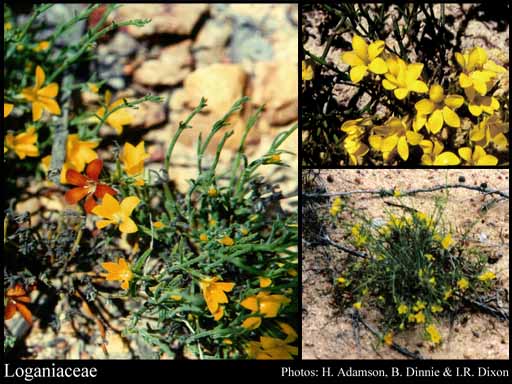- Reference
- Nov.Gen.Sp.Pl. 2:133 (1827)
- Name Status
- Current

Scientific Description
Common name. Logania Family.
Habit and leaf form. Trees, shrubs, herbs, and lianas, or herbaceous climbers. Self supporting, or climbing. Mesophytic. Leaves opposite; connate, or not connate; simple. Leaf blades entire; pinnately veined; cross-venulate. Leaves more or less with stipules (sometimes with colleters), or without stipules (but then the opposing bases connected by lateral lines). Stipules interpetiolar (or represented by a stipular sheath); free of one another, or concrescent; often much reduced; with colleters (secreting mucilage), or without colleters. Domatia recorded (Coinochlamys); represented by pockets. Stem anatomy. Nodes unilacunar (with 1–several traces), or tri-lacunar, or multilacunar. Secondary thickening developing from a conventional cambial ring, or anomalous; via concentric cambia.
Reproductive type, pollination. Fertile flowers hermaphrodite. Unisexual flowers absent. Plants hermaphrodite.
Inflorescence and flower features. Flowers aggregated in ‘inflorescences’ (usually), or solitary; in cymes (when not solitary). The terminal inflorescence unit usually cymose. Inflorescences terminal; cymes. Flowers bracteate; bracteolate; regular; 4–5 merous; cyclic; tetracyclic. Hypogynous disk small or absent. Perianth with distinct calyx and corolla; 8–10; 2 -whorled; isomerous. Calyx 4–5; 1 -whorled; gamosepalous; imbricate; bilabiate; when K 5 with the median member anterior. Corolla 4–5; 1 -whorled; gamopetalous; imbricate, or contorted (rarely); regular. Androecium (1–)4–5. Androecial members adnate (epipetalous); free of one another; 1 -whorled. Androecium exclusively of fertile stamens. Stamens (1–)4, or 5; reduced in number relative to the adjacent perianth to isomerous with the perianth; oppositisepalous; all alternating with the corolla members. Anthers dehiscing via longitudinal slits; introrse. Gynoecium 2 carpelled. The pistil 1 celled, or 2 celled, or 3 celled. Gynoecium syncarpous; synstylovarious, or eu-syncarpous; superior, or partly inferior (rarely). Ovary unilocular, or plurilocular; 1 locular, or 2 locular, or 3 locular. Gynoecium median; stylate. Styles 1; attenuate from the ovary; apical. Placentation when unilocular, parietal; usually axile. Ovules in the single cavity when unilocular, 25 (or more); 25 per locule (or more); anatropous, or hemianatropous.
Fruit and seed features. Fruit non-fleshy; dehiscent; a capsule. Capsules septicidal, or loculicidal, or valvular. Seeds endospermic; winged, or wingless. Cotyledons 2. Embryo straight (usually), or curved. Seedling. Germination phanerocotylar.
Physiology, biochemistry. Aluminium accumulation not found.
Geography, cytology, number of species. World distribution: pantropical, and a few warm temperate. 130 species.
Keys
Western Australian Genera and Families of Flowering Plants — an interactive key
T.D. Macfarlane, L. Watson, N.G. Marchant